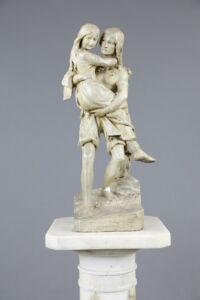November 22, 2019

Image from HHM Collections
In the Hennepin History Museum there is one of three small 1917 reproductions of Jacob Fjelde’s famous statue Hiawatha and Minnehaha. Some of you may have visited the much larger bronze version of this statue during visits to Minnehaha Park along the creek, near the falls. While its current location is a perfect spot for the representation of such a fabled tale, Fjelde’s statue journeyed to many places before it could call Minnehaha Falls its home.
Thanks to Henry Wadsworth Longfellow, the names Minnehaha and Hiawatha are recognizable throughout the country, and without a doubt, Minneapolis embraced his 1855 epic poem, The Song of Hiawatha. This is made evident by the naming of the Longfellow Neighborhood, the renaming of Wakpa Cistinna, Dakota for Little River, to Brown’s Creek, to Minnehaha Creek, Lake Amelia to Lake Nokomis, and Rice Lake to Lake Hiawatha; all important characters in Longfellow’s poem. Another addition to Minneapolis’ fondness of the story is the magnificent bronze statue Hiawatha and Minnehaha by Jacob Fjelde, who also created the statue of Ole Bull in Loring Park.
The history of this statue is quite unique. In 1893, sculptor Jacob Fjelde was commissioned to create a work of art that would be displayed in the Minnesota Building at the World’s Columbian Exposition in Chicago later that year. Since The Song of Hiawatha was ingrained in America’s popular culture and the two protagonists were members of an Ojibwe tribe, Hiawatha, and a Dakota tribe, Minnehaha, Fjelde was inspired to incorporate this well-known story into his work. His plaster statue, that depicts Hiawatha tenderly carrying Minnehaha, was put at the entrance of the Minnesota Building.
After the exposition, the statue was moved to the Minneapolis Central Library where it was prominently displayed. Almost a decade later in 1902, there was a push to use the original plaster statue to cast a bronze version and install it near Minnehaha Falls. This, however, was met with some opposition. Many people thought the faces of Hiawatha and Minnehaha did not look enough like the two groups of people they were modeled after. During Fjelde’s process of making the first plaster statue, he could not meet with local Native Americans to study their form and facial features, so his best option was using photographs. Unfortunately for those who wanted a truer representation, Fjelde passed away eight years earlier in 1896 at the age of forty-one. Since changes were not possible, the bronze version was made once there was enough funding, and in 1912, there was an unveiling ceremony in Minnehaha Park.
A reporter from The Minneapolis Morning Tribune noted in their September 12th column that “Hiawatha will stand on a base of boulders on the little island just above the falls where he will have an effective background of trees and will be able to hear for all time the murmuring voice of his Minnehaha.” There could not be a more fitting location to place this bronze statue. A week later, on October 5, 1912, the ceremony took place with great fanfare. To start the program, the first president of the Minneapolis Park Board, Charles Loring, gave a dedicatory speech, children from the nearby Longfellow School recited portions of Henry Wadsworth Longfellow’s epic poem, and to cap it all off, the nieces of Fjelde placed a wreath on the statue in honor of their uncle. Be it near Minnehaha Falls or in our collection at Hennepin History Museum, the memory of Hiawatha, Minnehaha, and Jacob Fjelde lives on through his statues.
Sources
“Bronze Statue of Hiawatha to Be Placed at Minnehaha.” The Minneapolis Morning Tribune (Minneapolis), September 29, 1912.
“Hiawatha and Minnehaha.” Historic Twin Cities. April 04, 2019. Accessed July 18, 2019. http://www.historictwincities.com/2018/11/30/hiawatha-and-minnehaha/.
Huber, Molly. “Hiawatha and Minnehaha (sculpture).” MNopedia. Accessed July 18, 2019. http://mnopedia.org/thing/hiawatha-and-minnehaha-jacob-fjelde.
“Minnehaha Regional Park.” Minneapolis Park & Recreation Board. Accessed July 18, 2019. https://www.minneapolisparks.org/parks__destinations/parks__lakes/minnehaha_regional_park/
